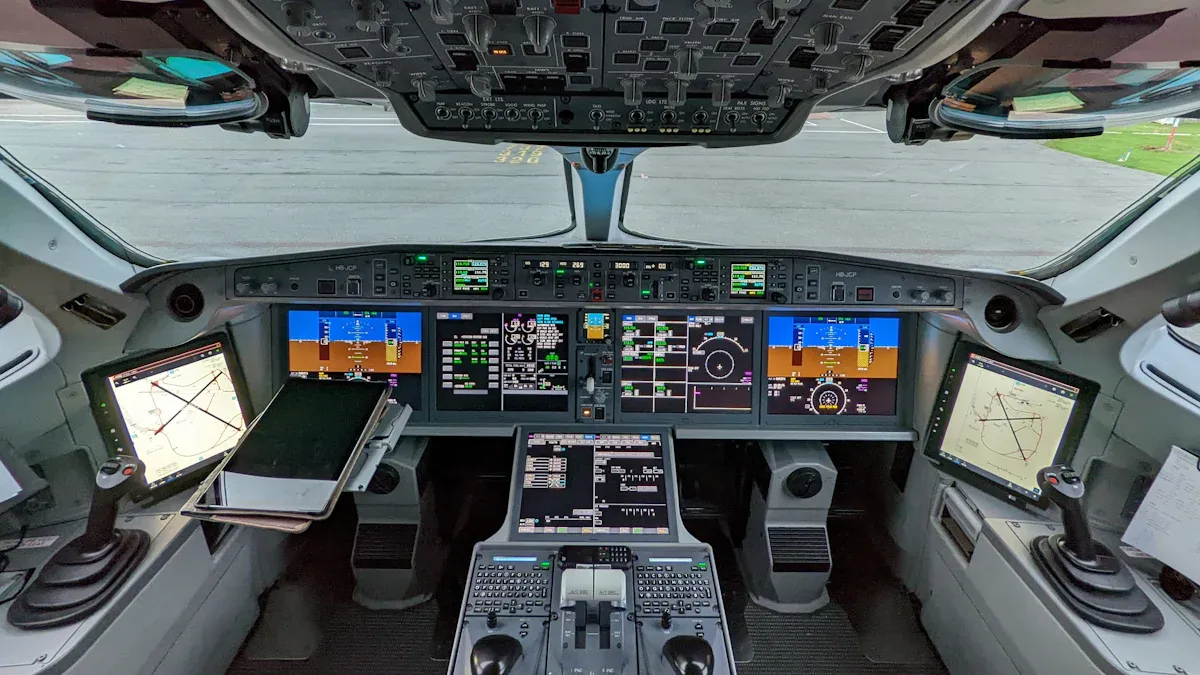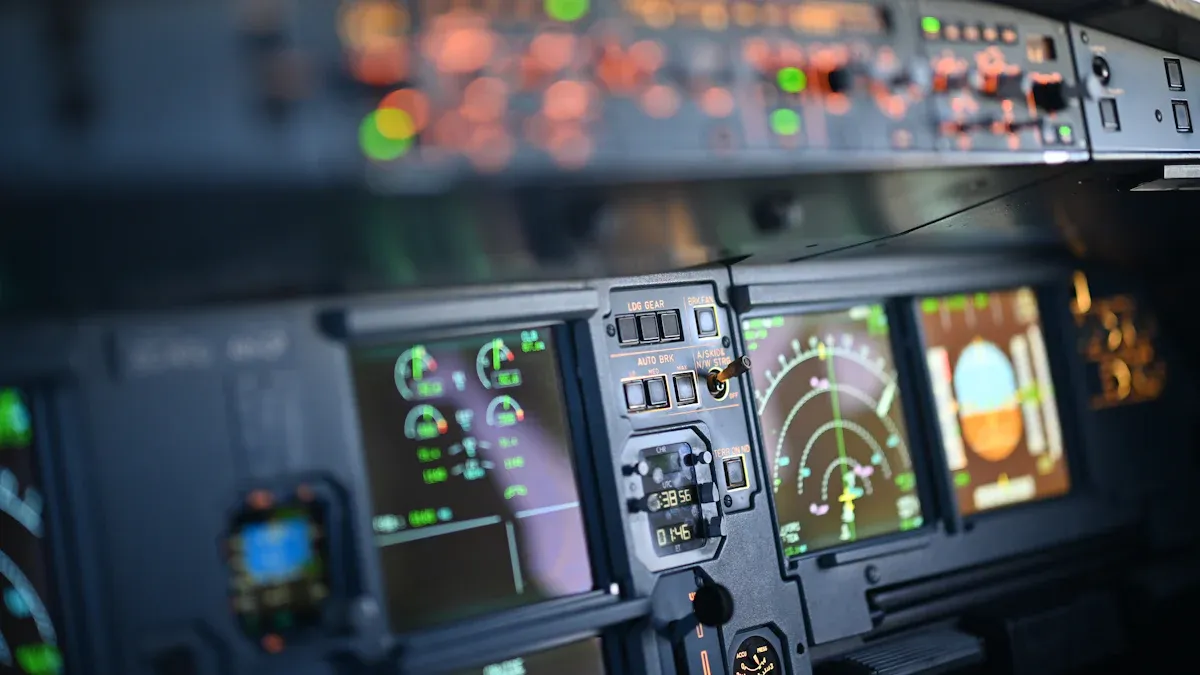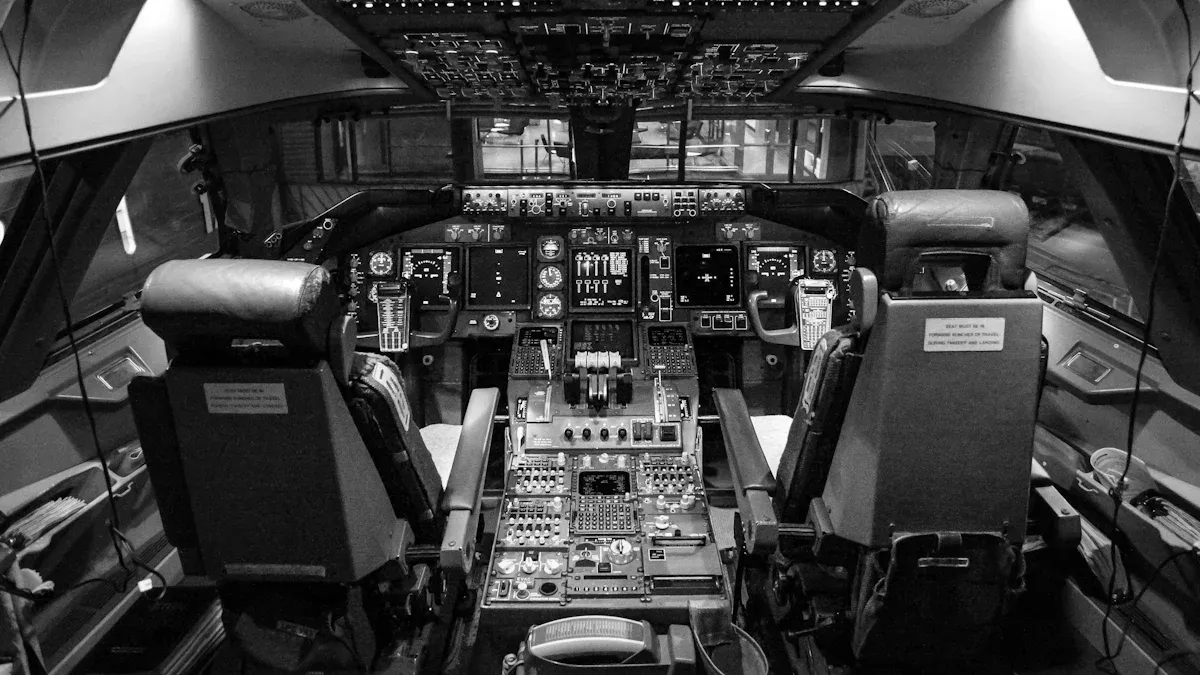Understanding the Impact of Chip Shortages on Avionics Systems

The worldwide chip shortage has affected important industries like avionics. Avionics chips are needed for systems like navigation and safety. The shortage shows problems in the chip supply chain. Factories can’t make enough chips, causing delays and higher prices. As the problem grows, it impacts aviation systems more. This shows we need quick solutions to fix it.
Key Takeaways
The worldwide chip shortage slows down making planes. This affects safety and communication tools in new airplanes.
Chips are more expensive now, so plane makers and airlines pay more. This raises ticket prices for travelers.
Companies that make airplane systems should use more suppliers and study new ideas. This can lower risks from chip shortages and make production faster.
Working together with makers, suppliers, and governments is key. It helps improve the chip supply chain and get chips on time.
New tech like AI and shared hardware can help fix chip shortages. They make supply chains better and speed up making special parts.
Causes of the Semiconductor Shortage
Supply Chain Disruptions
Problems in the supply chain are a big reason for the chip shortage. The COVID-19 pandemic caused factories to stop working and delayed shipments everywhere. When factories closed, the need for semiconductors grew fast, but there weren’t enough chips to meet the demand. Even after factories reopened, it took over a year to get chips, leaving industries like avionics struggling to keep up.
Chip factories have been working almost at full capacity since 2019. This means they can’t easily handle surprises or problems. For example:
In 2019, companies had 40 days of chip inventory, but by 2021, it dropped to less than 5 days.
Big manufacturers are spending money to make more chips, but it will take years to see results.
Relying too much on certain areas for chip production makes the supply chain weak. Trade rules and political issues make it even harder for companies to get the chips they need.
Note: The U.S. CHIPS Act and similar plans in Europe and South Korea aim to make more chips locally. These efforts will help, but it will take time to fix the supply chain.
Geopolitical Tensions and Trade Wars
Political problems and trade fights have hurt the global semiconductor supply chain. The U.S. used to make 37% of the world’s chips, but now it only makes 12%. This has made countries like Taiwan and South Korea very important for chip production. However, depending on these countries creates risks, especially as trade rules get stricter.
For example:
U.S. rules stopping chip technology exports to China have slowed production for Chinese companies.
Lam Research, a big chip equipment company, expects to lose up to $2.5 billion in 2023 because of these rules.
Companies are moving production to places like Vietnam and India, but building factories there costs a lot and takes time.
These problems make chips more expensive and harder to get, which hurts industries like avionics that need them. Working together globally is important to make the supply chain stronger and more reliable.
Rising Demand for Avionics Chips
The need for avionics chips has grown quickly because of new aviation technology. Modern planes use semiconductors for important systems like navigation, communication, and safety. As the aviation industry expands, it needs more powerful chips.
By 2025, the market for avionics parts could be worth over $80 billion, growing about 5.5% each year. By 2030, it might pass $100 billion. This fast growth has made it harder to get enough chips, adding pressure to the already tight market.
Tip: To handle this demand, avionics companies should try new ideas like using different suppliers and better planning tools. These steps can help reduce the effects of shortages and keep improving aviation technology.
Limited Manufacturing Capacity
Making enough avionics chips is a big problem for aviation. The need for chips is growing faster than factories can make them. This happens because making chips for avionics is harder than for other industries.
Most factories focus on making chips for everyday gadgets. This leaves aviation and military industries struggling to get the special chips they need. These industries need chips that last longer or use unique materials. Making these chips takes more time and effort.
Factories make new chips for gadgets faster than for planes.
Avionics systems need older, long-lasting chips that factories don’t prioritize.
Factories prefer making chips for bigger markets, not smaller ones like aviation.
Relying on foreign factories for advanced chips adds risks for national security.
You might ask why factories don’t just grow to meet demand. Building new chip factories costs billions and takes years to finish. Even with help from programs like the U.S. CHIPS Act, progress is slow. Defense and aviation industries also have different plans, making it harder to get chips efficiently.
To fix this, the aviation industry needs new ideas. Using more suppliers and improving chip-making methods can help. Governments and companies working together could build factories for aviation needs faster. These changes can keep avionics systems safe and reliable, even with limited chip production.
Impacts of the Global Chip Shortage on Avionics Systems

Delays in Aircraft Production
The worldwide chip shortage has slowed airplane production a lot. Modern planes need avionics chips for safety, navigation, and communication. When these chips are hard to find, building planes takes longer. Companies can’t finish planes on time without the needed semiconductors. This delay affects airlines and passengers too.
Plane makers say delays can last weeks or even months. These problems happen because they can’t get the special parts they need. Some projects are delayed more than others as companies focus on certain planes first. With more people wanting new planes, these delays are getting worse. This shows how important it is to find solutions quickly.
Tip: To avoid delays, companies should work closely with chip suppliers and find new ways to get parts.
Increased Costs for Avionics Manufacturers
The chip shortage has made things more expensive for avionics makers. When chips are rare, their prices go up. Companies have to pay more for the semiconductors they need. This raises the cost of making planes. Tariffs tied to the shortage also make prices higher, adding 6–11% more costs.
These higher costs don’t just affect manufacturers. Airlines often pay more, which can mean higher ticket prices for passengers. Companies also spend extra money on things like storing chips or changing designs to use different parts. These fixes help but cost a lot.
Main effects of higher costs:
Chips and semiconductors cost more.
Extra money spent on redesigning systems or finding new parts.
Tariffs linked to the chip shortage raise expenses.
You can see how these rising costs make it harder for the aviation industry to stay affordable and efficient.
Challenges in Developing New Avionics Technologies
The chip shortage has slowed down new technology for avionics. New ideas are important for making flying safer and better. But without enough semiconductors, it’s hard to create new systems.
More people want new planes, which adds pressure to the supply chain. Companies face problems that stop them from making advanced systems. For example, factories that make wafers can’t keep up with demand. Without strong teamwork between avionics companies and chip makers, progress slows down.
Problems with innovation:
Not enough special chips for new systems.
Supply chain issues hurt research and development.
More industries competing for the same chips.
Note: Working closely with wafer makers and trying new technologies can help solve these problems.
Risks to Aircraft Safety and Maintenance
The chip shortage has caused big problems for airplane safety. Avionics chips are important for systems like navigation and engine checks. Without these chips, planes might not work safely.
How Shortages Affect Plane Repairs
Planes need regular repairs to stay safe. But missing parts, like avionics chips, make fixing planes harder. Repair teams often wait longer to get parts. This can keep planes grounded for more time.
Main problems with repairs:
Fixes take longer because parts are missing.
Older parts are used, but they might not be as safe.
Rare parts cost more money to buy.
Alert: Using old or fixed parts for repairs can make planes less safe during flights.
Safety Problems from Missing Chips
Modern planes need avionics chips for key systems. These chips help with autopilot and avoiding crashes. When chip production slows down, airlines struggle to keep systems working well.
Possible safety issues:
Navigation systems might not work right during flights.
Pilots and air traffic controllers may have trouble talking clearly.
Emergency alarms might not respond fast enough.
Long-Term Safety Problems from Chip Shortages
The shortage makes companies focus on newer planes first. Older planes may get fewer updates, which can make them less safe. Depending on foreign factories for special chips also adds risks to the supply chain.
Problem | Effect on Plane Safety |
|---|---|
Missing parts | Repairs and fixes take longer |
Old avionics chips | Systems don’t work as well |
Supply chain problems | Harder to get important safety parts |
Tip: To make planes safer, companies should work closely with chip makers. Using more suppliers and building local factories can help fix the supply chain.
Strategies to Handle Chip Shortages
Using Many Semiconductor Suppliers
Working with many suppliers can lower chip shortage risks. Depending on one supplier can cause big problems if they fail. Having multiple suppliers ensures you get chips even during shortages.
Companies with many suppliers deliver products 20% faster.
This method avoids having too many or too few chips.
Watching all suppliers closely helps you react to changes quickly.
This plan makes your business stronger and keeps customers happy. It also helps manage rising chip prices while keeping a steady supply for avionics systems.
Spending on Research and Development
Spending money on research can solve chip-making problems. Research helps find new ways to make chips faster and better. For example, new methods can replace old ones that take longer.
You can also create new materials or designs for chips. This reduces the need for rare resources and opens new options for avionics. By focusing on research, you fix today’s problems and prepare for future ones.
Using Smart Forecasting Tools
Smart tools can help predict and fix supply chain issues. These tools use AI to study data and give accurate predictions.
Feature | What It Does |
|---|---|
AI Demand Prediction | Improves accuracy by 20% using smart data analysis. |
Real-Time Tracking | Shows supply chain problems as they happen. |
Multi-Agent System | Uses special AI helpers for different supply tasks, making the process smoother. |
These tools help spot problems in chip production early. You can act fast to fix them, ensuring a steady chip supply and fewer disruptions in your work.
Strengthening Collaboration Across the Industry
The global chip shortage shows teamwork is very important. Companies, suppliers, and governments must work together to solve problems. Working as a team helps keep semiconductors available for avionics systems.
Why Collaboration Matters
One company alone cannot fix the chip shortage. Avionics systems need many parts from different suppliers. Sharing plans and resources can reduce delays and improve production. For example:
Manufacturers can tell suppliers their schedules to avoid slowdowns.
Suppliers can focus on aviation when chips are limited.
Governments can help by funding research and building factories.
Tip: Talk often with partners to find problems early and fix them fast.
Examples of Successful Collaboration
Some industries show how teamwork solves problems. In 2023, aerospace companies worked with chipmakers to track chip supplies. This system cut delays by 15%.
Car makers also teamed up to buy chips in bulk. This gave them better prices and a steady supply. Avionics companies can use these ideas to stay competitive.
How You Can Contribute
You can help teamwork by:
Joining industry groups to share ideas and solutions.
Meeting suppliers often to talk about problems.
Funding shared projects that help everyone in the supply chain.
Note: Building trust takes time but helps everyone in the long run.
By working together, the avionics industry can handle the chip shortage and prepare for the future.
The Role of Emerging Technologies in Addressing Chip Shortages

Innovations in Chip Manufacturing
New technologies are changing how we solve chip shortages. Factories now use methods like 3D chip stacking. This packs more parts into smaller spaces, saving time and materials. New materials, such as gallium nitride, are also replacing silicon in some chips. These materials last longer and work better, making them great for avionics systems.
Governments and companies are building factories closer to home. This reduces the need to rely on other countries and avoids shipping delays. Faster approval for new parts also helps use these technologies sooner without risking safety. These changes ensure avionics systems get the chips they need on time.
AI and Machine Learning for Supply Chain Optimization
AI and machine learning are helping manage supply chains better. These tools study large amounts of data to predict problems early. For example, AI can track chip production live and warn about delays.
Machine learning also helps plan inventory. It predicts how many chips are needed, so you don’t run out or order too many. Special AI programs handle different tasks to make the process smoother. These tools save money and ensure chips reach avionics makers quickly.
Exploring Open-Source Hardware for Avionics
Open-source hardware is another way to solve chip shortages. Sharing designs freely lowers costs and speeds up production. This teamwork between avionics makers, chip producers, and researchers leads to creative ideas.
For avionics, open-source designs help create custom parts faster. Instead of waiting for special chips, you can build your own using shared designs. Partnerships between public and private groups make this even stronger. This keeps avionics systems working well, even during chip shortages.
Tip: Using open-source hardware not only solves current problems but also helps invent better systems for the future.
The worldwide chip shortage is causing problems for avionics. It leads to delays, higher prices, and slower progress. To fix this, companies can use more suppliers, fund research, and try new technologies. By 2025, digital tools will help track parts and improve supply chains. Working with groups like the Aviation Supply Chain Integrity Coalition can ensure safer systems. Solving these issues now will create a stronger future for avionics.
FAQ
What makes avionics chips different from regular chips?
Avionics chips are made for important tasks like navigation and safety. They can handle tough conditions, like heat and shaking. These chips last longer and are more reliable to keep planes safe.
Tip: Special materials and methods are used to meet strict aviation rules.
How long will the chip shortage affect the avionics industry?
Experts think the shortage will last until 2026. Making new factories and fixing supply chains takes time. Improvements will come slowly as governments and companies invest in making more semiconductors.
Note: Keep up with industry news to plan better during this time.
Can older chips be used in modern avionics systems?
Sometimes, but not always. Older chips might not work well or meet safety needs. Always check with manufacturers to make sure they follow aviation rules.
Alert: Using old chips without testing can make planes unsafe.
How can avionics companies reduce their reliance on foreign chip suppliers?
Work with local manufacturers to get more suppliers. Spend money on research to find new solutions. Teaming up with governments to build local factories can make supply chains stronger.
Emoji Insight: 🌍 Balancing global and local suppliers is a smart strategy.
Are open-source hardware designs safe for avionics systems?
Yes, if they pass strict tests and certifications. Work with trusted partners to make sure they meet aviation standards. Open-source designs can also help save money and speed up progress.
Tip: Always check open-source solutions for safety before using them.
